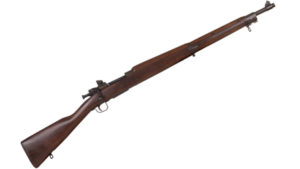After the failure of the standard issue Model 1896 Krag Rifle during the Spanish American war, the United States Army was looking for an improved firearm for its troops. The rifle they developed would go on to become one of the best ever built, and would be used for decades in the trenches and foxholes anywhere Americans were fighting. That rifle was the Model 1903 Springfield, and at The National Interest, the Warfare History Network tells its story:
The shortcomings of the Krag-Jorgensen became apparent during the Spanish-American War of 1898. Its cumbersome locking system, coupled with a low-powered cartridge, and its difficulty in adapting to clip-loading made it unfavorable compared to the Spaniards’ more effective charger-loaded German Model 1893 Mauser rifle, with its higher muzzle velocity, greater accuracy, and ability to be modified for clip-loading.
The result was that the United States Army Ordnance Board authorized the Springfield Armory, located in Springfield, Massachusetts, to manufacture an experimental magazine rifle based on the Mauser and Krag. They tested their prototype during October and November 1900; as a result of these trials, the Board recommended the new weapon be adopted by the Army. The design was stronger than the Krag-Jorgensen; with fewer parts it was cheaper to build and easier to operate; and it could be easily fitted with a Mauser-type magazine.
The United States Government followed the Board’s recommendation and entered into arrangements with the Mauser Company to build a modified Mauser at a cost of $200,000. To employ a better cartridge than was currently in service, the 1900 prototype was replaced by another experimental rifle, developed in 1901. This was described by the Chief of Ordnance as “embodying all the merits of the present service arm and has been made, with simpler machining cuts, fewer parts and doubled lugged bolt for use of a cartridge giving 2,200 or more feet per second velocity…” The new 1901 Model replaced the knife-like bayonet of the Krag-Jorgensen with a sliding rod bayonet mechanism of the kind used in the Model 1884 Caliber.45 trap door Springfield rifle. Tests of the 1901 experimental rifle led to the design of a slightly improved weapon: the prototype 1902, which used a 220-grain blunt- nose shape bullet rimless .30 caliber round which, although more powerful than its predecessor, caused severe bore erosion.
On June 20, 1903, after all tests of the 1901 and 1902 experimental rifles were completed, and the Board of Ordnance’s recommended changes were issued, orders went out to the Springfield Armory, to start manufacturing 225 and 125 Model 1903 rifles per day, respectively. Since it was first manufactured at the National Armory at Springfield, the rifle came to be known as the “1903 Springfield Rifle”. Its official title was the “US Magazine Rifle, Caliber .30 Model of 1903”. Eventually, the Springfield Armory would be directed to produce 700 per day.
Developers first featured the 1903 Springfield along a two-piece, single-banded wooden body with a straight stock. Internal mechanisms were held at the rear of the body with the 24” barrel protruding a short distance ahead of the fore end. The bolt handle, situated over the right side of the receiver, had a ball at its end to ensure an easier handgrip. The magazine was internal and fixed in place, requiring the use of cartridge “chargers” (prefabricated strips containing five cartridges). Front and end iron sights were fitted to the weapon, rounding out the weapon’s weight to about nine pounds. The 1903, a short rifle successfully filled the dual role of an accurate infantry weapon and a carbine for use by mounted troops.
Read more here.
Originally posted on Your Survival Guy.
If you’re willing to fight for Main Street America, click here to sign up for the Richardcyoung.com free weekly email.






